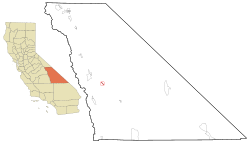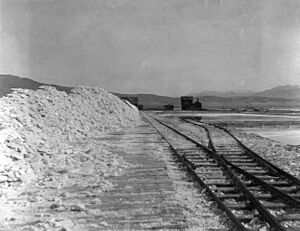Keeler, California facts for kids
Quick facts for kids
Keeler, California
|
|
|---|---|

Abandoned Carson and Colorado Railroad train depot in Keeler, CA
|
|

Location in Inyo County and the state of California
|
|
| Country | United States |
| State | California |
| County | Inyo |
| Area | |
| • Total | 1.302 sq mi (3.373 km2) |
| • Land | 1.302 sq mi (3.373 km2) |
| • Water | 0 sq mi (0 km2) 0% |
| Elevation | 3,603 ft (1,098 m) |
| Population
(2020)
|
|
| • Total | 71 |
| • Density | 54.5/sq mi (21.05/km2) |
| Time zone | UTC-8 (Pacific (PST)) |
| • Summer (DST) | UTC-7 (PDT) |
| ZIP code |
93530
|
| Area codes | 442/760 |
| FIPS code | 06-37918 |
| GNIS feature ID | 2408466 |
Keeler, once called Hawley, is a small, unincorporated community in Inyo County, California. It is located on the eastern side of Owens Lake. In 2020, 71 people lived in Keeler. It is considered a special area by the United States Census Bureau for counting purposes.
Contents
History of Keeler
Early Days and Mining
Keeler's story began after a big earthquake in 1872. The earthquake damaged a pier in a nearby town called Swansea. So, a new pier was built further south in a community then known as Hawley.
In 1880, a new mill was built in Hawley. This mill was used to process silver ore. The silver came from the Cerro Gordo Mines in the mountains to the east. A man named Julius M. Keeler helped plan the town. Later, Hawley was renamed Keeler after him.
Transportation and Growth
A steamship named Bessie Brady helped transport ore. It carried ore from Keeler across Owens Lake to the town of Cartago. This boat trip saved days compared to wagons going around the lake. The Bessie Brady could carry 700 heavy metal bars at a time. It made the trip in about three hours. Sadly, the ship was destroyed by fire in 1882.
In 1883, the Carson and Colorado Railroad built a special narrow-gauge railway to Keeler. The town grew quickly because the Cerro Gordo mines were doing very well. However, when silver prices dropped in the late 1800s, the town's growth slowed down.
Later Mining and Decline
Keeler saw a second boom in the early 1900s. This time, it was due to zinc mining. A special cable tramway was built to bring zinc ore from Cerro Gordo to Keeler. There were also smaller bursts of mining for silver, lead, and limestone. But by the 1950s, all mining in the area had stopped.
Train service to Keeler ended in 1960. The train tracks were removed in 1961. Another big change happened in the 1920s. Water from the Owens Valley was sent to the city of Los Angeles. This caused Owens Lake to dry up completely. As a result, strong alkali dust storms would blow through Keeler. Many residents moved away because of the dust.
In the early 2000s, efforts were made to reduce the dust. This helped with the problem. However, only a few residents still live in Keeler today. A post office has been operating in Keeler since 1883 and is still open. There is also a California Historical Landmark in Keeler. It marks the old furnace of the Owens Lake Silver Company.
Geography of Keeler
Keeler covers an area of about 1.3 square miles (3.37 square kilometers). All of this area is land. The community is located along the eastern edge of Owens Lake. Owens Lake is now a dry lakebed. Keeler is also found along State Route 136.
Population Information
Keeler's Population in 2010
In 2010, Keeler had a population of 66 people. Most of the people living there were White. A small number of people were Asian, and some identified as Hispanic or Latino. All residents lived in homes. The average household had about 1.7 people. Many households were single-person homes. The median age of residents was 59.3 years.
Keeler's Population in 2000
In 2000, Keeler also had 66 people living there. There were 36 households and 19 families. Most residents were White. A small percentage were from other backgrounds. The average household size was 1.8 people. Many households had one person, especially those aged 65 or older. The median age was 57 years.
See also
 In Spanish: Keeler (California) para niños
In Spanish: Keeler (California) para niños



